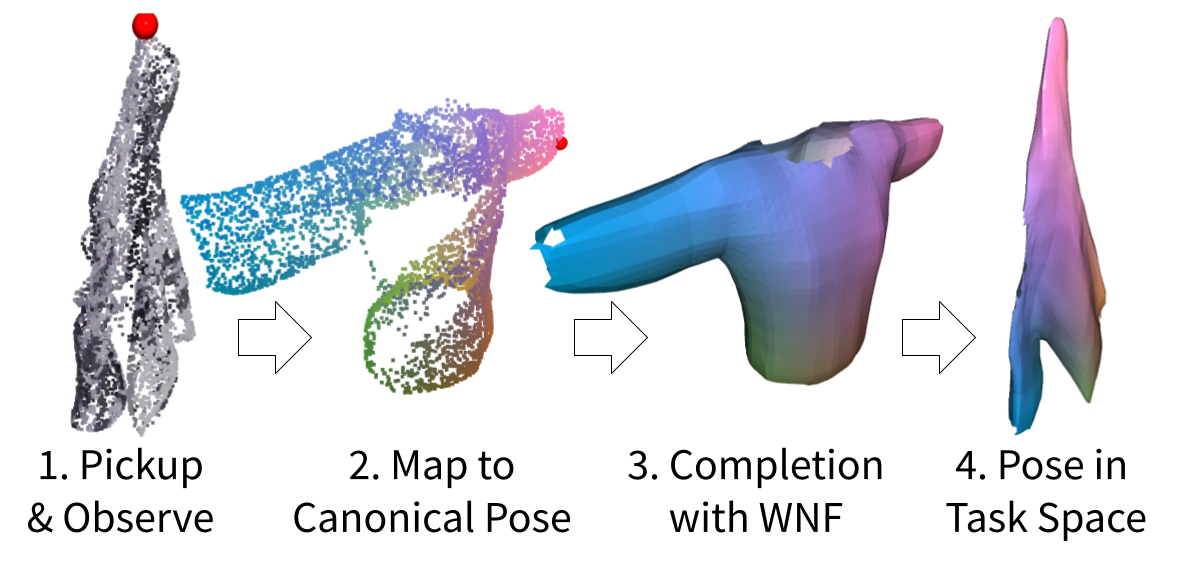This repository contains the source code for the paper GarmentNets: Category-Level Pose Estimation for Garments via Canonical Space Shape Completion. This paper has been accepted to ICCV 2021.
@inproceedings{chi2021garmentnets,
title={GarmentNets: Category-Level Pose Estimation for Garments via Canonical Space Shape Completion},
author={Chi, Cheng and Song, Shuran},
booktitle={The IEEE International Conference on Computer Vision (ICCV)},
year={2021}
}
-
GarmentNets Dataset (GarmentNets training and evaluation) Split in parts
-
GarmentNets Simulation Dataset (raw Blender simluation data to generate the GarmentNets Dataset) Split in parts
-
CLOTH3D Dataset (cloth meshes in a canonical pose)
The GarmentNets Dataset contains point clouds before and after gripping simulation with point-to-point correspondance, as well as the winding number field (
The GarmentNets Simulation Dataset contains the raw vertecies, RGBD images and per-pixel UV from Blender simulation and rendering of CLOTH3D dataset. Each cloth instance in CLOTH3D is simulated 21 times with different random gripping points.
Both datasets are stored using Zarr format.
🆕 If your internet connection is not stable, please try to download part files for our datasets using command
$ wget --recursive --no-parent --no-host-directories --relative --reject="index.html*" https://garmentnets.cs.columbia.edu/dataset/garmentnets_dataset_parts/
and then combine the part files into a complete tar file for extraction:
$ cat garmentnets_dataset.zarr.tar.part* > garmentnets_dataset.zarr.tar
Upon popular demand, we added a small subset of our datasets, which contains 25 instances of the Tshirt category. We are also working on alternative ways to host the complete datasets for reserchers outside of the United States.
GarmentNets are trained in 2 stages:
- PointNet++ canoninicalization network
- Winding number field and warp field prediction network
The checkpoints for 2 stages x 6 categories (12 in total) are all included. For evaluation, the checkpoints in the garmentnets_checkpoints/pipeline_checkpoints directory should be used.
A conda environment.yml for python=3.9, pytorch=1.9.0, cudatoolkit=11.1 is provided.
conda env create --file environment.yml
Alternatively, you can directly executive following commands:
conda install pytorch torchvision cudatoolkit=11.1 pytorch-geometric pytorch-scatter wandb pytorch-lightning igl hydra-core scipy scikit-image matplotlib zarr numcodecs tqdm dask numba -c pytorch -c nvidia -c rusty1s -c conda-forge
pip install potpourri3d==0.0.4
Assuming the project directory is ~/dev/garmentnets.
Assuming the GarmentNets Dataset has been extracted to <PROJECT_ROOT>/data/garmentnets_dataset.zarr and GarmentNets Pretrained Models has been extracted to <PROJECT_ROOT>/data/garmentnets_checkpoints.
Generate prediction Zarr with
(garmentnets)$ python predict.py datamodule.zarr_path=<PROJECT_ROOT>/data/garmentnets_dataset.zarr/Dress main.checkpoint_path=<PROJECT_ROOT>/data/garmentnets_checkpoints/pipeline_checkpoints/Dress_pipeline.ckpt
Note that the dataset zarr_path and checkpoitn_path must belong to the same category (Dress in this case).
Hydra should automatically create a run directory such as <PROJECT_ROOT>/outputs/2021-07-31/01-43-33. To generate evaluation metrics, execute:
(garmentnets)$ python eval.py main.prediction_output_dir=<PROJECT_ROOT>/outputs/2021-07-31/01-43-33
The all_metrics_agg.csv and summary.json should show up in the Hydra generated directory for this run.
As mentioned above, GarmentNets are trained in 2 stages. Using a single Nvidia RTX 2080Ti, training stage 1 will take roughly a week and training stage 2 can usually be done overnight.
To retrain stage 2 with a pre-trained stage 1 checkpoint:
(garmentnets)$ python train_pipeline.py datamodule.zarr_path=<PROJECT_ROOT>/data/garmentnets_dataset.zarr pointnet2_model.checkpoint_path=<PROJECT_ROOT>/data/garmentnets_checkpoints/pointnet2_checkpoints/Dress_pointnet2.ckpt
To train stage 1 from scratch:
(garmentnets)$ python train_pointnet2.py datamodule.zarr_path=<PROJECT_ROOT>/data/garmentnets_dataset.zarr
